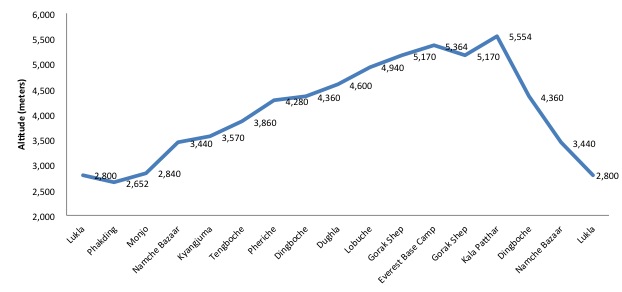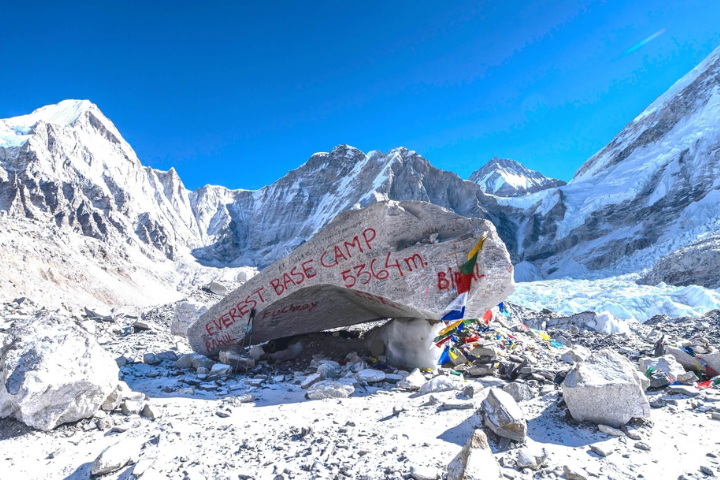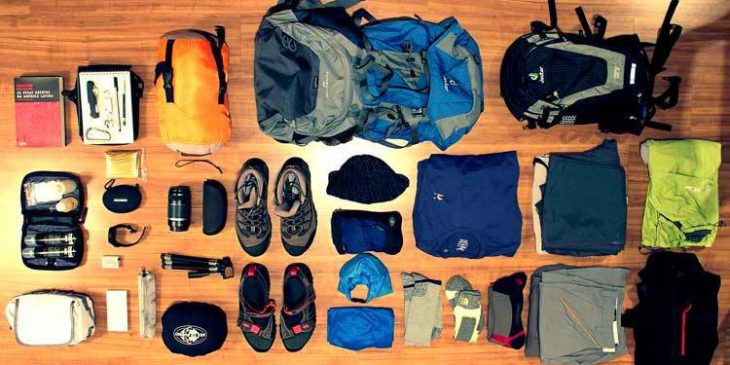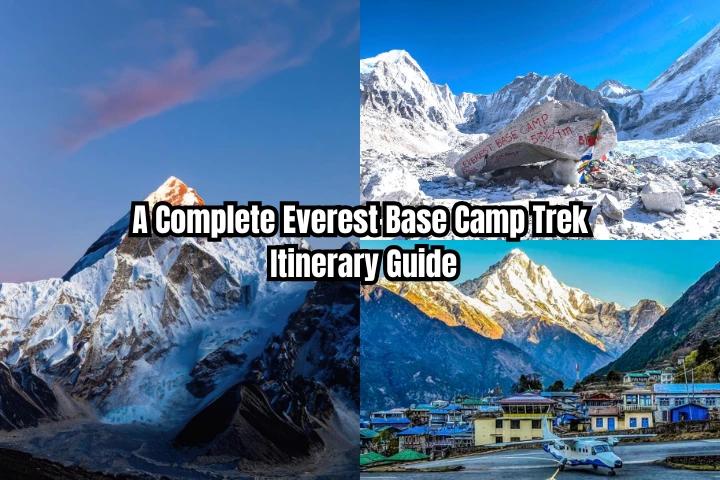So, you’re dreaming of trekking to the iconic Everest Base Camp?
That’s incredible! It’s an adventure of a lifetime that promises breathtaking views and a sense of accomplishment like no other adventure does. The journey to the base of the world’s highest peak is as much about the experience as it is about the destination. But one of the first questions you might have is: how long is the Everest Base Camp trek itinerary? Let’s dive into the details of this iconic trekking itinerary.
The Everest Base Camp trekking itinerary is an approximately 130-kilometer round trip that typically takes trekkers between 14 to 16 days. This timeframe includes both the ascent to the base camp and the descent back to the starting point. But why does it take this long?
Let’s break it down into more detail to understand the unique aspects of this trek.
Understanding the Role of Altitude

Unlike a straightforward hike, like Pokhara valley or Thulakot Hill hikes, the Everest Base Camp trek is a high-altitude expedition. The challenge of altitude during this trek cannot be underestimated. As you climb higher, the oxygen level decreases, making each step more and more difficult than the last one. This is why acclimatization is crucial.
The human body needs time to adjust to the thinner air, and rushing this process can lead to altitude sickness, a potentially dangerous condition. Ensuring your body adapts well at each stage of the climb is vital for a successful trek.
Importance of Acclimatization Days During the Everest Base Camp Trek Itinerary
The Everest Base Camp trekking itinerary is not just about walking to a high-altitude place; it’s about acclimatizing to the altitude to prevent altitude sickness. The Everest Base Camp trekking itinerary is deliberately structured to include several acclimatization days where you stay at a certain altitude to help your body adapt to the lower oxygen level at the higher altitude.
During these acclimatization days, you can explore local areas, engage in nearby shorter hikes, and enjoy the stunning surroundings while allowing your body to adjust to the altitude.
This acclimatization process during the EBC trek not only aids in health and safety but also enhances the overall experience by giving you time to soak in the cultural and natural beauty of the region.
Physical and Mental Challenges of the EBC Trek
The trek to Everest Base Camp is physically demanding due to the long distances walked each day and the challenging terrain. Trekkers must navigate rocky paths, steep inclines, and suspension bridges, all while carrying their gear.
Mental fortitude is equally important. The journey tests your perseverance, patience, and ability to stay motivated despite fatigue and changing weather conditions.
Preparing mentally and physically beforehand can make a significant difference in your trekking experience, assisting in the success of the trek.
Everest Base Camp Trek Itinerary

While itineraries can vary slightly depending on the trekking company or personal preferences, here is a typical breakdown of the Everest Base Camp trek itinerary. Understanding each day’s journey can help you prepare both physically as well as mentally for the adventure ahead.
Day 1: Arrival in Kathmandu
Get settled and prepare for the adventure ahead. Kathmandu, the vibrant capital of Nepal, offers a rich cultural experience. Spend the day exploring its bustling streets, historic temples, and savoring local cuisine. Use this time to ensure that all your trekking gear is in order and meet with your trekking group for a pre-trek briefing.
Day 2: Flight to Lukla and Trek to Phakding
Begin your trek with a short yet thrilling flight from Kathmandu to Lukla, one of the most renowned mountain airports in the world. Upon reaching Lukla, you’ll start your trek to Phakding.
This initial walk is relatively easy, allowing you to ease into the trekking routine as you pass through charming villages and lush landscapes.
Day 3: Trek from Phakding to Namche Bazaar
Journey to the bustling Sherpa town of Namche Bazaar. The path takes you through pine forests and across the Dudh Koshi River via suspension bridges. As you approach Namche, the trail becomes steeper, but the panoramic views of Everest and other Himalayan peaks make the effort worthwhile.
Day 4: Acclimatization Day in Namche Bazaar
Spend a day exploring Namche Bazaar and acclimatizing. Take the opportunity to visit the Sherpa Museum or hike up to Everest View Hotel for stunning vistas of Everest, Lhotse, and Ama Dablam.
Engaging in light activities helps your body adjust to the altitude. Spending time with the local Sherpa people is one of the best ways to spend your day in Namchee.
Day 5: Trek from Namche Bazaar to Tengboche
Continue the trek to Tengboche, home to the famous Tengboche Monastery. The trail offers breathtaking views of the Himalayas, and upon arrival, you can visit the monastery, which is the largest in the Khumbu region. Witness the evening prayer ceremony for a spiritual experience.
Day 6: Trek from Tengboche to Dingboche
Travel through rhododendron forests and cross rivers to reach Dingboche. This village is a popular stop for acclimatization, offering beautiful views of the surrounding peaks. The terrain becomes more rugged, reminding you that you’re venturing deeper into the heart of the Himalayas.
Day 7: Acclimatization Day in Dingboche
Another rest day to acclimatize, with options for short hikes. You might choose to hike to Nagarjun Hill for panoramic views or explore the local area.
Rest days like this are essential to prevent altitude sickness and to conserve energy for the days ahead.
Day 8: Trek from Dingboche to Lobuche
Head towards the small settlement of Lobuche, surrounded by stunning peaks. The trail continues to ascend, and the landscape becomes more stark and dramatic. You’ll pass through the memorials of climbers who lost their lives in the region, which is a poignant reminder of the mountain’s power.
Day 9: Trek from Lobuche to Gorak Shep and Everest Base Camp
Reach Gorak Shep and then make the final push to Everest Base Camp. This is the most anticipated day of the trek. The path is challenging, but the sight of the base camp surrounded by towering peaks and the Khumbu Icefall is an unforgettable reward.
Day 10: Trek from Everest Base Camp to Kala Patthar to Pheriche
Begin the descent, heading back to the village of Pheriche. The descent is faster but requires caution as your body might still be adjusting to the altitude. Enjoy the changing perspectives of the landscapes you’ve trekked through.
Day 11: Trek from Pheriche to Namche Bazaar
Make your way back to Namche Bazaar, retracing your steps. The return journey offers a new appreciation for the path you’ve traveled and the people you’ve met along the way. Take time to relax and reflect in Namche.
Day 12: Trek from Namche Bazaar to Lukla
Continue your descent to Lukla. This final trekking day is bittersweet as you leave the stunning mountain vistas behind. Celebrate your accomplishments with your trekking team before your return flight.
Day 13: Flight from Lukla to Kathmandu
Fly back to Kathmandu and celebrate your achievement! Enjoy a well-deserved rest and explore more of the city’s vibrant culture. Share your journey stories with fellow trekkers and friends.
Day 14: Departure from Kathmandu
Conclude your EBC trek, farewell the capital of Nepal with tons of memories and motivation to visit Nepal again.
Factors That Influence the Everest Base Camp Trek Itinerary Duration
While the typical Everest trek time is around 14 to 16 days, several factors can influence the duration of your EBC trek. Understanding these factors can help in planning and ensuring a smoother trekking experience.
Acclimatization and Health
As mentioned earlier, acclimatization is crucial. Some trekkers may need additional rest days, especially if they experience symptoms of altitude sickness.
Symptoms can include headaches, dizziness, and nausea. It’s important to listen to your body and be prepared to adjust your itinerary if necessary. Your health and safety should always take precedence over sticking to a schedule.
Weather Conditions
The weather in the Everest region can be unpredictable. Flights to and from Lukla are often delayed due to fog or bad weather, which can extend your trip. The high-altitude weather can change rapidly, affecting trail conditions and visibility.
Always have a buffer day or two in your schedule to accommodate these potential delays and ensure you don’t miss your international flight home.
Fitness Level and Experience
Your trekking experience and fitness level can also affect how long your trek takes. While the trek doesn’t require advanced mountaineering skills, being physically fit will make the journey more enjoyable and possibly faster.
Experienced trekkers might find themselves more comfortable with the daily distances and altitudes. However, novices should not be discouraged; with proper preparation, the EBC trek is achievable for most.
Best Seasons to Trek
The best times to trek to Everest Base Camp are spring (March to May) and autumn (September to November). These seasons offer the most stable weather conditions, which can influence how smooth your trek is.
During these periods, the trails are less likely to be affected by snow or rain, and the views are often clearer. However, these are also the busiest times, so expect more fellow trekkers on the trails.
Winter, however, is the least recommended as the trail is filled with snow, making the trek extremely difficult and slippery as well. Winter is only for experienced trekkers.
Summer is not recommended for anyone, as during this time, due to extreme downpour, the trail becomes slippery and full of leeches. Moreover, due to continuous rainfall, the risk of floods and landslides increases. Most of the accommodation in summer is closed, leaving the fewest options for staying.
Preparing for the Everest Base Camp Trekking Itinerary

Preparation is key to a successful trek to Everest Base Camp. From physical training to packing the right gear, each aspect plays a critical role in your experience.
Physical Preparation
Start preparing physically at least a few months before your trek. Focus on cardio exercises like running, cycling, or swimming to build stamina. Include strength training to prepare your muscles for long days of hiking. Working on your core stability and leg strength can help prevent injuries. Incorporating hikes into your routine, especially at higher altitudes if possible, can also be beneficial.
Mental Preparation
The trek is as much a mental challenge as it is a physical one. Prepare yourself for long days, varying weather conditions, and the possibility of altitude sickness.
Staying positive and determined will help you push through tough days. Mindfulness and meditation practices can help maintain focus and composure during challenging moments. Visualizing your trek and setting small daily goals can also enhance your mental resilience.
Packing Essentials
Pack wisely! You’ll need layered clothing to handle temperature changes, sturdy trekking boots, a good quality sleeping bag, and other essentials like a first-aid kit, sunscreen, and a water purification system. Invest in good quality gear to ensure comfort and safety. Pack light, but don’t skimp on essentials. Remember, you will be carrying your pack for long distances, so every item should have a purpose.
Head
- Warm hat & cap
- Sunglasses with UV protection
- Headlight
- Beanie
- Earmuffs
Body
- Thermal layers
- Warm and Waterproof jacket
- Thermal Gloves
- Trekking Trousers and Shorts
- Neck buff
- Waterproof gloves
Footwear
- Trekking shoes
- Hiking boots
- Warm Hiking socks
- Gaiters
Essentials/Equipment
- Sleeping bag
- First aid kit
- Trekking poles & Duffel bag
- Water Bottles and Hydration Bladders
- Raincoat
- High-energy snacks
- Reliable oxygen supply
- Maps & Compass/GPS
Final Thoughts
Trek to Everest Base Camp is a journey filled with awe-inspiring landscapes and personal triumphs. While the Everest Base Camp trek itinerary is generally around 14 to 16 days, being flexible with your schedule and prepared for varying conditions will ensure a safe and rewarding experience. So, lace up those boots, pack your gear, and get ready for an adventure like no other! The EBC trek is not just a physical journey but a transformative experience that leaves a lasting impression on your soul.
Remember, the mountains are calling, and it’s time for you to answer! Embrace the challenge and cherish every moment of this incredible adventure.
FAQS
How many days do you need at Everest Base Camp?
The typical trekking itinerary of the Everest Base Camp is approximately 14 to 16 days. However, various factors may extend the itinerary durations, like:
– Fitness
– Altitude Sickness
– Weather Change
– Natural Calamities
Can a beginner do Everest Base Camp?
Yes, an individual without any prior trekking experience can make the Everest Base Camp trek. However, the trekker needs to be physically and mentally fit, ready to face any challenges such as fatigue, stress, rough climate, altitude sickness, and long hours of walking.
What is the hardest day of Everest Base Camp?
Day 9, trek from Lobuche to Gorak Shep and then to Everest Base Camp, is one of the hardest days of the EBC Trek. On day 9, you have to climb to an altitude above 5,000 m where the oxygen is thinner. Also, the trial combines with the trekking over the glacier and rocky terrain, making the walk even more difficult after a week of walking prior.
What is the elevation of Everest Base Camp?
The Everest Base Camp elevation is 5,364 meters (17,600 feet) above sea level.
Where is Everest Base Camp?
One of the most iconic trekking destinations, the Everest Base Camp, is located in the Solukhumbu District, Nepal. Situated at the heart of the Khumbu Region, the EBC trek’s coordinates are 28.0043° N, 86.8557° E.
